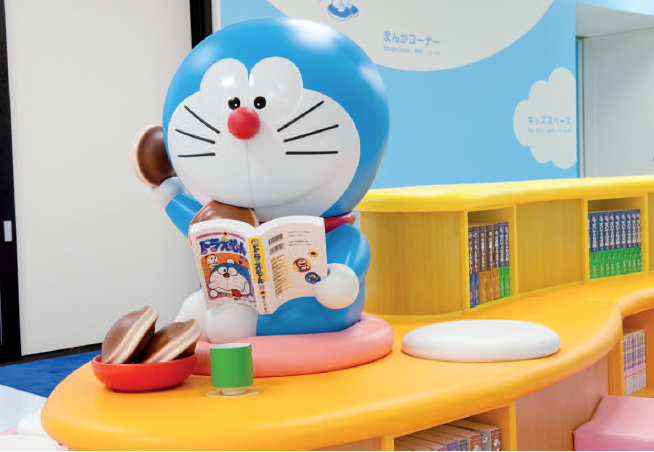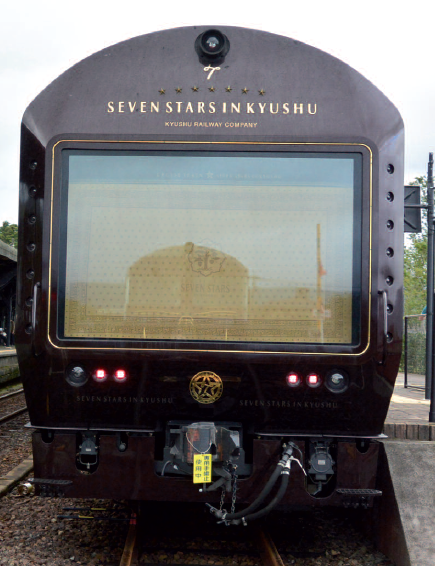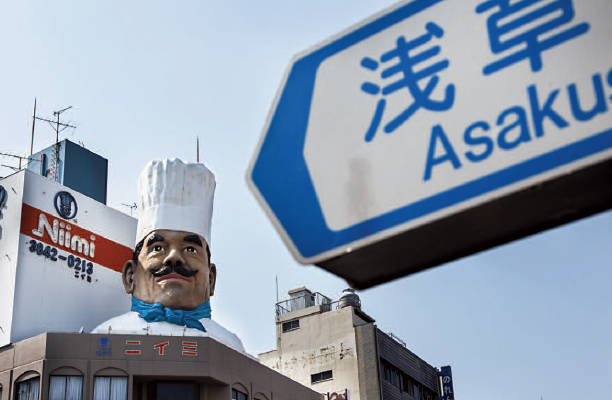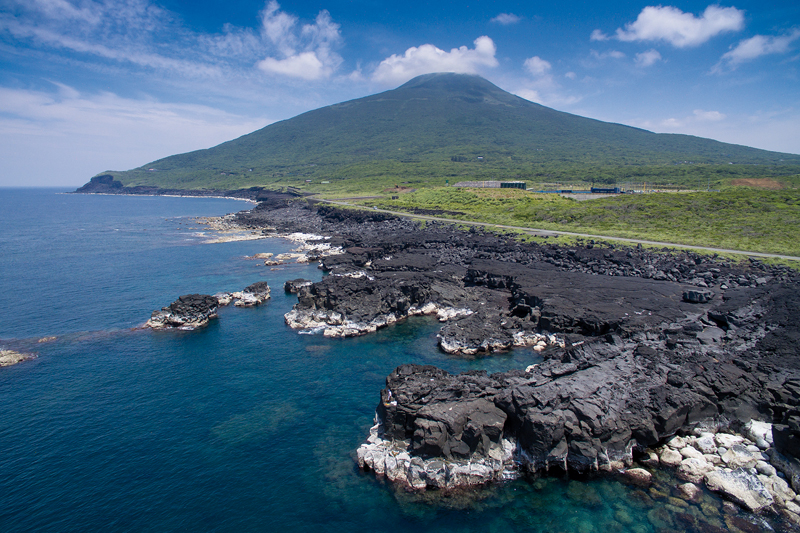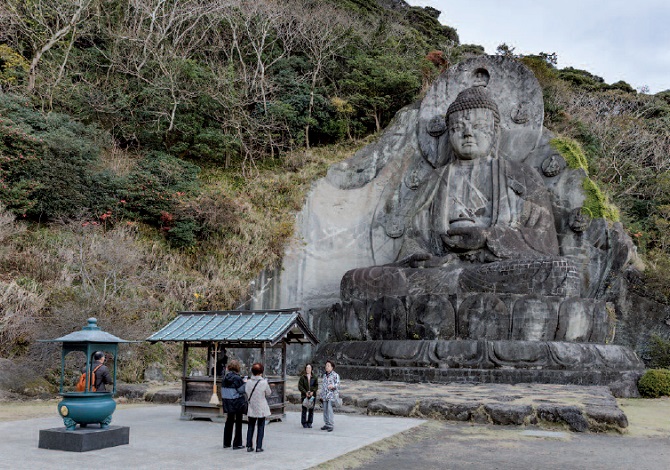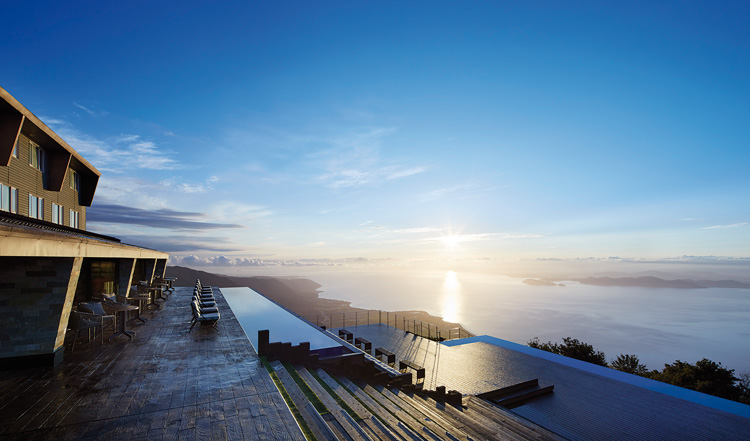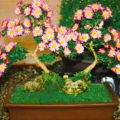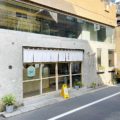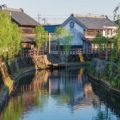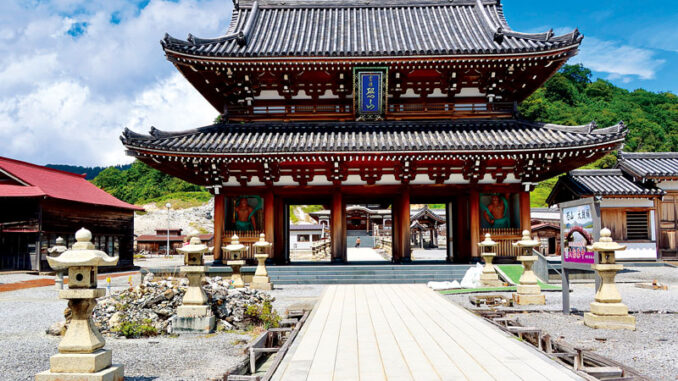
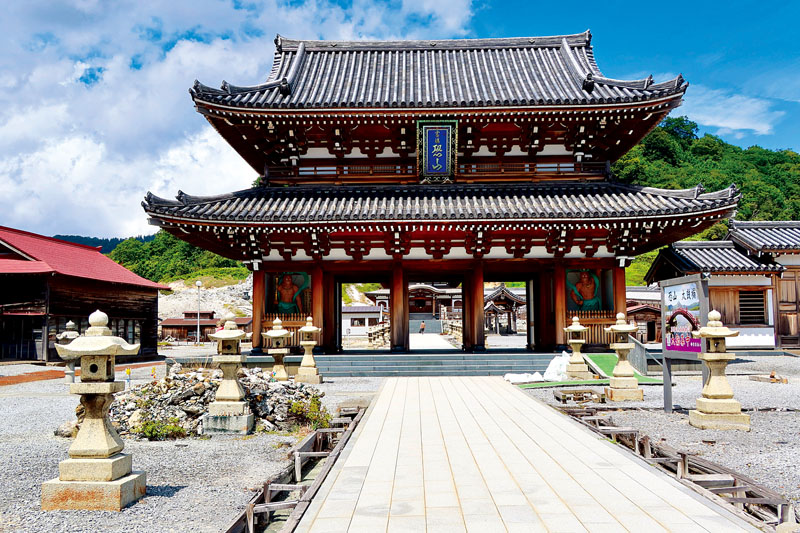
Situated at the northernmost tip of the main island of Honshu, this region is a hotbed of beliefs…
The Shimokita Peninsula hovers over Honshu like a giant axe, seemingly ready to split the top of Japan’s main island in two. It’s also reminiscent of the scythe wielded by the Grim Reaper, the human skeleton dressed in a shroud that’s one of the more common personifications of Death.
Although the images evoked by the shape of the peninsula may be the fruit of morbid fantasies, for centuries Shimokita has indeed been associated with death. As the last part of Honshu to be “civilized”, the Tohoku region is rich in ancient folklore that far predates both Shintoism and Buddhism, and one of the main centres of such folk religious folk practices is Osore-zan, or Mount Osore. Believers consider this place to be one of the three sacred spots in Japan where the spirits of the dead reside and can be contacted through mediums.
Osore-zan, by the way, means Mount Dread and no name could be more appropriate. Indeed, a visit to this desolate place is an unforgettable, hair-raising experience. Let’s see why.
The narrow mountain road leading to Osore-zan is lined with Buddhist statues carved from stone, which once marked the way for religious pilgrims walking up the sacred mountain. Along the way, the bus stops at a spot where icy water channelled from a mountain stream is supposed to guarantee long life to those who stop for a drink. Apparently, the mountain channels more than water: when I tried to take a photo of that spot from the bus, my camera suddenly went crazy and resumed working only after the bus left.
The road twists and climbs through a thick forest until, after the final curve, it abruptly ends at Mount Dread’s barren crater, and the deep green of the trees is replaced by a vast landscape of grey desolation – a greyness that’s only broken by the blue of the deathly still Lake Usori. It’s a stunning, forbidding scene.
On the way to the bus terminal, we pass by a small river and a red bridge. The lake is at the mouth of the Sanzu River, which according to local tradition carries the spirits of the dead and marks the separation between the physical and spiritual worlds.
As soon as we get off the bus, our noses are assaulted by the smell of rotten eggs. In fact, Osore-zan is an active volcano, and the strong sulphuric odour comes from the crater’s many bubbling hot springs, which range in colour from blood red to bright yellow. The area around the lake is filled with volcanic gas (sulphur dioxide), and even in Mutsu’s city centre, its strong smell can fill the air when carried by northwest winds.
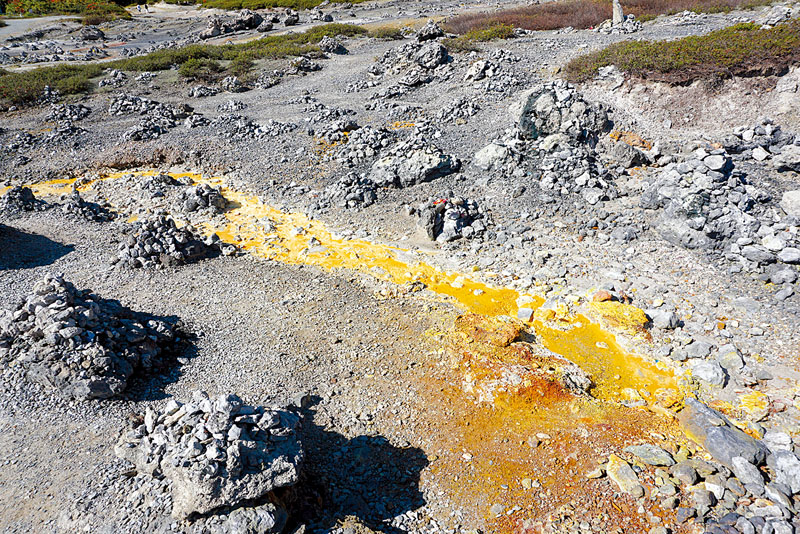
Although Osore-zan is an active volcano, there are no historical records of eruptions, and geological surveys indicate that the last eruption occurred over 10,000 years ago. Granted, mild volcanic activity (water vapour and volcanic gas) is frequent, and the area is subject to the system of “Eruption Warnings and Forecasts for Disaster Reduction” launched by the Japan Meteorological Agency on 1 December 2007. However, the place is fairly safe and is not listed among the 43 Japanese volcanoes for which the eruption alert level has been introduced.
The same thing can be said for the volcanic gas. Some people experience headaches and fatigue when visiting Mt. Osore. These are not spiritual phenomena, but rather symptoms of mild poisoning caused by the toxic gas. Though, in general, it’s not particularly dangerous, older people who are physically weak and small young children need to be careful. Sparks caused by incense sticks, candles and cigarettes can also ignite the stagnant volcanic gas, so their use outside of designated areas is strictly prohibited.
The real piece de resistance in this dreadful yet beautiful area is Bodai-ji, a Buddhist temple originally founded in 862 CE. Although early folk religion had already recognized the mountain as sacred, Buddhism was quick to envelop this desolate place with its own mythology.
According to legend, a monk named Ennin dreamed that one day he would build a temple to study the asceticism of the Tendai sect and help people understand the mystery of death. During his travels in Japan’s deep north, Ennin discovered this place. He was astonished at the volcanic basin, surrounded by eight mountain peaks and filled with a poisonous lake, which matched the vision he had in his dream. For Ennin, the boiling pools represented hell while the green of the surrounding mountains and the clarity of the lake were an ideal portrait of paradise.
Osore-zan has been an object of worship for local residents since before the 17th century. During the Meiji Period, several literary works described the place including the travelogue Ekishin gogo, written by the writer Koda Rohan during his visit in 1892. Afterward, a sulphur mine was built on the north shore of Lake Usori. At that time, sulphur was a valuable raw material for gunpowder, and the military turned the region into a restricted area. The mine was eventually closed in 1969 as the value of sulphur ore had plummeted after the war when methods for extracting sulphur from petroleum on a large scale became more practical. Even today, the remains of the mine still exist within the mountain.
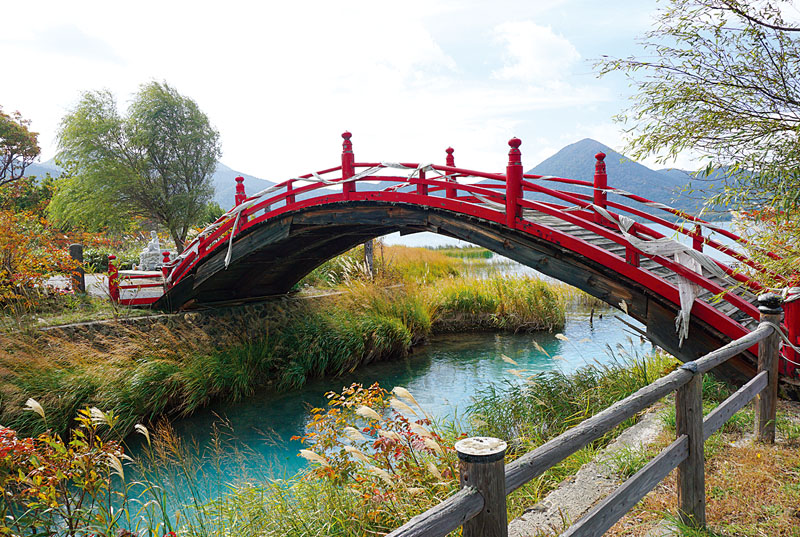
Sulphur apart, it became clear that the mountains around Osore-zan were rich in mineral resources (gold, silver, copper, lead, zinc, pyrite, titanium, manganese) due to volcanic activity. So the area surrounding the temple grounds became a mining district. Bars and red-light districts sprang up along the prefectural road leading to Osore-zan, and the road itself was further developed for transporting ore down the mountain. All those mines are currently closed.
You need to pay a fee to enter Bodai-ji. The sprawling complex itself is worth a visit. The first thing you’ll notice while walking around the temple grounds are the small streams of hot spring water. Another interesting feature is the shiny stainless-steel roof over Jizo Hall, the building nearest the lake. The choice of roofing material does not seem so strange when you consider the effects of Mount Osore’s sulphuric atmosphere on the more traditional copper.
The hot spring gushing out within this sacred place is also used as a public bath. On the way to the lake, you’ll run into a couple of wooden bath houses free to anyone who does not mind the smell and extremely hot water.
Eventually, we leave the temple behind and make our way toward Lake Usori through a winding path surrounded by jagged, low rock formations, some warm to the touch, others with wisps of steam escaping from surface cracks, and others as cold as their gloomy surroundings. It’s a veritable lunar landscape, with the caldera lake looming in the distance. It’s easy to see why early visitors believed that this barren and forbidden scene had to be from another world. In fact, the local idiom for “kicked the bucket” is “gone to Tanabu” (the district where Osore-zan is located) or “gone to the mountain”.
The very presence of the hot springs was actually what created this kind of scenery. In the past, the water temperature was even higher and the combination of steam and bubbling water turned the place into a vision of hell.
As we approach the lake, Osore-zan’s lunar landscape suddenly becomes flat. Many years ago, the lake was wider and deeper than today. The water level kept rising and falling until the lake reached its current size and shape, leaving behind a large flat area. The contrast between the lake, with its white sandy beach and bright emerald green water, and the surrounding area could not be greater. If Osore-zan looks like hell, Lake Usori feels like paradise.
Again, there’s a scientific explanation for this. The sand contains a great deal of dacite, a kind of coloured quartz that’s formed when magma hardens. As for the water, it’s so crystal clear because hydrogen sulphide spews out from the lakebed, making it highly acidic (the equivalent of lemon juice) and preventing bacteria from growing. Indeed, after a while, one realizes that there are no fish in the lake, no animals in the surrounding area and hardly any plants as far as the eye can see. The lack of living creatures contributes to Mount Dread’s disquieting, hellish atmosphere.
Many Jizo statues are scattered between the temple buildings and the lake. By the end of the summer pilgrimage season, the stone figures are covered with colourful offerings of clothing and their bases overflow with coins, food, drinks and even toys. The red bibs and hand-knit caps the statues wear, together with the toys and other childhood accessories donated to the Jizo, lend an even more sombre note to Mount Osore’s already far-from-jolly atmosphere. Jizo are the guardian deities of children, and the offerings are to help them look after those children who have left our world and are making their way to the next. There are also many colourful mini-windmills spinning wildly all over the place. They are placed there as memorials to the dead as their spinning symbolizes reincarnation.
You’ll also notice donations of straw sandals around the statues. These are for the Jizo’s other role as guardians of the spirits of the dead of all ages. They make nightly patrols of the land between this world and the next, Sai-no-Kawara, and its rocky river bed causes the thin straw sandals to wear out rapidly. On their rounds, they comfort homeless spirits who are busy piling up stones for stupas (dome-shaped shrines) so they will be allowed to enter paradise. The Jizo also scare away the ever-present demons who are continually knocking down these piles. Some visitors to Osore-zan lend the struggling spirits a hand by creating small rock piles for them, or by adding a stone or two to existing ones. This practice is actually relatively recent as it was not very common until 30 or 40 years ago.
The rock piles and the Jizo’s patrolling are also the origin of the so-called “Three great wonders of Osore-zan”: even if you pile up rocks on the riverbank in the evening, they always collapse by the next morning; you can hear the sound of Jizo’s monk’s staff in the middle of the night while they wander the area; and when it rains in the middle of the night, the Jizo’s clothes inside the temple get wet.
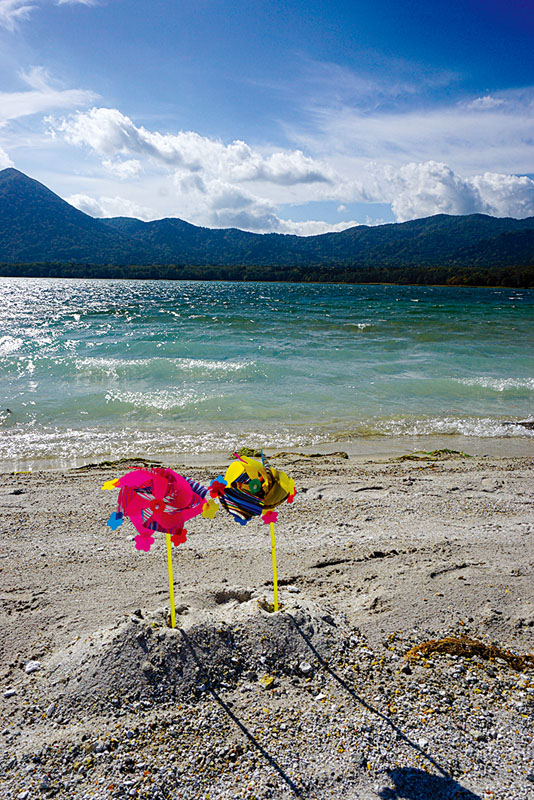
During the Osore-zan Grand Festival in late July and the Osore-zan Autumn Pilgrimage in early October, many people line up to have itako perform kuchiyose for them. Itako are specially trained blind women and kuchiyose is the act of contacting the spirit of the dead.
The itako (whose number has decreased greatly in recent years since many of them have died or are too old to continue their activity, and recruits are increasingly hard to find) usually live in Hachinohe and Aomori and only travel to Osore-zan for the yearly festivals. They stay in the so-called itakomachi (itako town), an area near the lake where they erect their tents, for the duration of the events.
Like the practice of piling up stones, it wasn’t until after the war that kuchiyose was carried out on Mt. Osore, and the monks at Bodai-ji are careful to stress that the temple is not involved in the itako’s activity. However, kuchiyose has proved very popular as many people travel to the sacred mountain to get in touch with departed loved ones. Unfortunately, the spirits only communicate in the medium’s strong Shimokita dialect, so foreigners – even those who speak Japanese – will not understand much. However, you can feel the eerie sensation of the spiritual world’s presence anytime you walk through Osore-zan’s strange landscape.
Osore-zan is one of those unique places where people come to commune with the dead and think about death – including their own. These days, people try as much as possible to stay away from those thoughts. We prefer to seal them away in a secret dark corner of our hearts. In this respect, if modernization is about removing death from everyday life, Osore-zan is where people come to terms with and accept their mortality.
Lake Usori is framed by several beautiful peaks, and the area around Mt. Osore has been designated as the Shimokita Peninsula Quasi-National Park. However, though the region seems to be prime hiking territory, there are almost no mountain trails. Besides, the mountains can be extremely steep, and though no animals live around Lake Usori, bears are often seen in the surrounding mountains.
For the time being, Osore-zan and the southern part of the peninsula (the axe handle) are relatively easy to reach thanks to JR’s Ominato Line which connects Ominato and Shimokita stations to Noheji and the rest of the railway network. Since the 1980s, JR has constantly threatened to discontinue this and other small local lines, but for now, the single-track line is safe. From Shimokita Station, a bus takes you to Osore-zan. Buses only run a few times a day, so you should check their schedules in advance.
Osore-zan has not completely been turned over to the spirit world. The soba shop outside the temple features sansai (mountain vegetables), which are supposed to prolong your stay in this world. The temple also runs an inn with relatively low room rates, though temple officials say they would rather rent their rooms to religious pilgrims than to tourists. Spending the night at Bodai-ji offers you an opportunity to eat vegetarian meals with the monks. Depending on how impressionable you are, you’ll find the sound of mini-windmills fluttering at night either soothing or extremely upsetting. Some say they hear children laughing in the dark.
Gianni Simone
To learn more on this topic, check out our other articles :
N°139 [FOCUS] 1 January, Noto Peninsula
N°139 [FOCUS] TOME – A tragedy for rice farming
N°139 [FOCUS] SHIKA – In the shadow of the nuclear power plan
N°139 [FOCUS] WAJIMA – The tragedy of trial by fire
Follow us !

